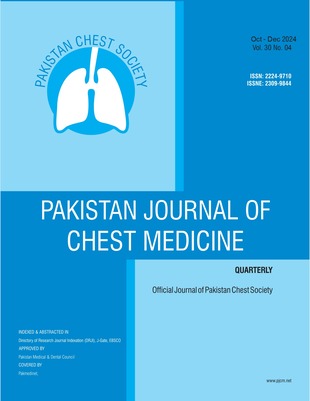Predictors of In-Hospital Mortality in COVID-19-Associated Hospital-Acquired Pneumonia: Experience from a Tertiary Care Hospital
Keywords:
COVID-19, Hospital-Acquired Pneumonia, Mortality, Inflammatory MarkersAbstract
Background: COVID-19 has significantly increased the risk of hospital-acquired pneumonia (HAP), especially in critically ill patients. The overlap of viral and secondary bacterial infections contributes to increased morbidity and mortality. Identifying key predictors of in-hospital mortality in such patients is essential for improving clinical outcomes and guiding targeted interventions. Objective: To identify and evaluate the clinical, laboratory, and microbiological factors associated with in-hospital mortality among patients diagnosed with COVID-19-associated hospital-acquired pneumonia (HAP) in a tertiary care setting. Methodology: A retrospective observational analysis was performed on 110 adult COVID-19 patients who had HAP ≥48 hours after hospitalization during the period from January 2023 to December 2023. Demographic, clinical, laboratory, and microbiological information were compared between non-survivors and survivors. Statistical significance was evaluated by using appropriate univariate tests. Results: Mortality was strongly correlated with advanced age (p = 0.01), chronic kidney disease (p = 0.01), ICU stay (p < 0.001), and mechanical ventilation (p < 0.001). Non-survivors had highly raised inflammatory and renal markers: ferritin >1000 µg/mL (p < 0.001), D-dimer >1.3 mg/L (p = 0.01), procalcitonin >2.0 ng/mL (p < 0.001), and creatinine >1.3 mg/dL (p = 0.001). Aspergillus species were much more frequent among non-survivors (31.8% vs. 12.1%, p = 0.05), indicating an association with higher mortality from invasive fungal infections. Conclusion: Advanced age, renal impairment, ICU-level treatment, mechanical ventilation, high inflammatory markers, and Aspergillus coinfection are major mortality predictors in COVID-19 patients with hospital-acquired pneumonia. These results underscore the need for earlier risk stratification, fungal diagnostics, and early intervention to minimize mortality in resource-constrained environments.References
Acter T, Uddin N, Das J, Akhter A, Choudhury TR, Kim S. Evolution of severe acute respiratory syndrome coronavirus 2 (SARS-CoV-2) as coronavirus disease 2019 (COVID-19) pandemic: A global health emergency. Sci Total Environ. 2020;730:138996. DOI: 10.1016/j.scitotenv.2020.138996.
Pal M, Berhanu G, Desalegn C, Kandi V. Severe acute respiratory syndrome coronavirus-2 (SARS-CoV-2): an update. Cureus. 2020;12(3):e7355. DOI: 10.7759/cureus.7355.
Pássaro L, Harbarth S, Landelle C. Prevention of hospital-acquired pneumonia in non-ventilated adult patients: a narrative review. Antimicrob Resist Infect Control. 2016;5(1):43. DOI: 10.1186/s13756-016-0143-0.
McEachern R, Campbell GD Jr. Hospital-acquired pneumonia: epidemiology, etiology, and treatment. Infect Dis Clin North Am. 1998;12(3):761–79. DOI: 10.1016/S0891-5520(05)70040-7.
Russell CD, Koch O, Laurenson IF, O'Shea DT, Sutherland R, Mackintosh CL. Diagnosis and features of hospital-acquired pneumonia: a retrospective cohort study. J Hosp Infect. 2016;92(3):273–9. DOI: 10.1016/j.jhin.2015.10.015.
SolÃs-Huerta F, Martinez-Guerra BA, Roman-Montes CM, Tamez-Torres KM, Rajme-Lopez S, OrtÃz-Conchi N, et al. Risk factors associated with the development of hospital-acquired infections in hospitalized patients with severe COVID-19. Antibiotics. 2023;12(7):1108. DOI: 10.3390/antibiotics12071108.
Kwon JH, Nickel KB, Reske KA, Stwalley D, Dubberke ER, Lyons PG, et al. Risk factors for hospital-acquired infection during the SARS-CoV-2 pandemic. J Hosp Infect. 2023;133:8–14. DOI: 10.1016/j.jhin.2022.11.012.
Rouzé A, Nseir S. Hospital-acquired pneumonia/ventilator-associated pneumonia and ventilator-associated tracheobronchitis in COVID-19. Semin Respir Crit Care Med. 2022;43(2):243–7. DOI: 10.1055/s-0042-1742330.
Sangmuang P, Lucksiri A, Katip W. Factors associated with mortality in immunocompetent patients with hospital-acquired pneumonia. J Glob Infect Dis. 2019;11(1):13–8. DOI: 10.4103/jgid.jgid_145_18.
Alonazi HH. Predictors of mortality among Saudi healthcare workers admitted to intensive care units (Master's thesis). Alfaisal Univ (Saudi Arabia). 2021.
Daniel MF, Xavier N, Mario G, Cesar E, Mario V, Edgar B, et al. The duration of mechanical ventilation is the main cause of bacterial/fungal superinfection in critically ill patients with COVID-19 at altitude. J Exp Pathol. 2022;3(2):55–64.
Zayed NE, Abbas A, Lutfy SM. Criteria and potential predictors of severity in patients with COVID-19. Egypt J Bronchol. 2022;16(1):11. DOI: 10.1186/s43168-022-00124-6.
Assal HH, Abdel-Hamid HM, Magdy S, Salah M, Ali A, Elkaffas RH, et al. Predictors of severity and mortality in COVID-19 patients. Egypt J Bronchol. 2022;16(1):18. DOI: 10.1186/s43168-022-00129-1.
Cilloniz C, Peroni HJ, Gabarrús A, GarcÃa-Vidal C, Pericà s JM, Bermejo-Martin J, et al. Lymphopenia is associated with poor outcomes of patients with community-acquired pneumonia and sepsis. Open Forum Infect Dis. 2021;8(6):ofab169. DOI: 10.1093/ofid/ofab169.
Chong WH, Saha BK, Neu KP. Comparing the clinical characteristics and outcomes of COVID-19-associated pulmonary aspergillosis (CAPA): a systematic review and meta-analysis. Infection. 2022;50(1):43–56. DOI: 10.1007/s15010-021-01625-7.
Kluge S, Strauß R, Kochanek M, Weigand MA, Rohde H, Lahmer T. Aspergillosis: emerging risk groups in critically ill patients. Med Mycol. 2022;60(1):myab064. DOI: 10.1093/mmy/myab064.
Downloads
Published
How to Cite
Issue
Section
License
Copyright (c) 2024 Pakistan Journal of Chest Medicine

This work is licensed under a Creative Commons Attribution-NonCommercial 4.0 International License.








